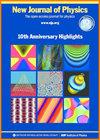Engineering quasi-bound states in the continuum in asymmetric waveguide gratings
IF 2.8
2区 物理与天体物理
Q2 PHYSICS, MULTIDISCIPLINARY
引用次数: 0
Abstract
The occurrence of quasi-bound states in the continuum (qBIC) in all-dielectric asymmetric grating waveguide couplers with different degrees of asymmetry under normal light incidence is analysed from the viewpoint of identifying the most promising configuration for realizing the highest quality (Q) factor under the condition of utmost efficiency (i.e. total extinction). Considering asymmetric gratings produced by altering every Nth ridge of a conventional (symmetric) grating coupler, we analyse different regimes corresponding to the interplay between diffractive coupling to waveguide modes and band gap effects caused by the Bragg reflection of waveguide modes. The symmetric and double- and triple-period asymmetric grating couplers are considered in detail for the same unperturbed two-mode waveguide and the grating coupler parameters that ensure the occurrence of total transmission extinction at the same wavelengths. It is found that the highest Q is expected for the double-period asymmetric grating, a feature that we explain by the circumstance that the first-order distributed Bragg resonator (DBR) is realized for this configuration while, for other configurations, the second-order DBR comes into play. Experiments conducted at telecom wavelengths for all three cases using thin-film Al2O3-on-MgF2 waveguides and Ge diffraction gratings exhibit the transmission spectra in qualitative agreement with numerical simulations. Since the occurrence of considered qBIC can be analytically predicted, the results obtained may serve as reliable guidelines for intelligent engineering of asymmetric grating waveguide couplers enabling highly resonant, linear and nonlinear, electromagnetic interactions.非对称波导光栅连续体中的工程准约束态
我们分析了全介质非对称光栅波导耦合器在正常光入射条件下不同不对称程度的连续体中准束缚态(qBIC)的发生,目的是找出在最高效率(即全消光)条件下实现最高质量(Q)因子的最有前途的配置。考虑到非对称光栅是通过改变传统(对称)光栅耦合器的每N个脊而产生的,我们分析了与波导模式的衍射耦合和波导模式的布拉格反射所引起的带隙效应之间的相互作用相对应的不同状态。我们详细研究了对称光栅耦合器、双周期和三周期非对称光栅耦合器,对于相同的无扰动双模波导和光栅耦合器参数,这些参数可确保在相同波长上发生全透射消光。我们发现,双周期不对称光栅的 Q 值最高,这是因为这种配置采用了一阶分布式布拉格共振器(DBR),而其他配置则采用了二阶分布式布拉格共振器。在电信波长下,使用 Al2O3-on-MgF2 薄膜波导和 Ge 衍射光栅对所有三种情况进行了实验,结果显示传输光谱与数值模拟结果基本一致。由于可以分析预测所考虑的 qBIC 的发生,因此所获得的结果可作为非对称光栅波导耦合器智能工程的可靠指南,从而实现高谐振、线性和非线性电磁相互作用。
本文章由计算机程序翻译,如有差异,请以英文原文为准。
求助全文
约1分钟内获得全文
求助全文
来源期刊

New Journal of Physics
物理-物理:综合
CiteScore
6.20
自引率
3.00%
发文量
504
审稿时长
3.1 months
期刊介绍:
New Journal of Physics publishes across the whole of physics, encompassing pure, applied, theoretical and experimental research, as well as interdisciplinary topics where physics forms the central theme. All content is permanently free to read and the journal is funded by an article publication charge.
 求助内容:
求助内容: 应助结果提醒方式:
应助结果提醒方式:


